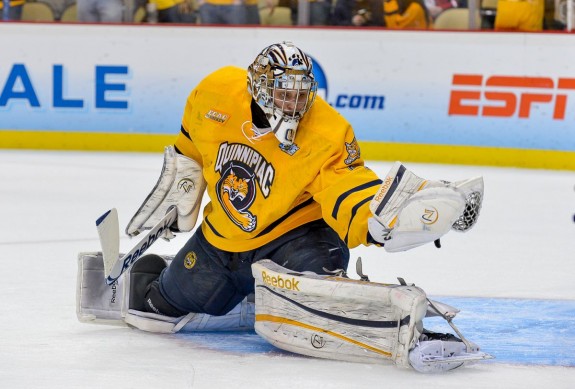
According to College Hockey Incorporated, 31% of the players in the NHL were developed in division I college hockey. If you’re a hockey prospect that needs more time to develop as a hockey player, division I college hockey is a very good route to go. Moreover, division I college hockey is becoming the fastest growing development path to the NHL.
I was reading a blog post written by Tim Redinger that was posted on the Sabres Noise. Redinger’s post brought up some interesting issues, but missed the mark a bit. First, college hockey isn’t for everybody. Not everyone can be the next Jonathan Quick, Jonathan Toews or Zach Parise. Players must meet certain requirements to be eligible. Also, you also don’t have to play for a NCAA powerhouse to get noticed by the NHL scouts. Players just have to impress the NHL scouts.
Tim Redinger, Sabres Noise — If the NHL is your goal, and you have outgrown junior hockey – why not get yourself recruited by an NCAA powerhouse to help develop your skills at another level?
The Buffalo Sabres should have done that with Mikhail Grigorenko three years ago. You’re too good for juniors, but not quite ready for us, let us help you get into college where you can up the ante a little bit without breaking the rules for the CHL/NHL agreement and since you can’t play in the AHL. Would have been a match made in heaven, and both sides would have benefited.
Returning to the NCAA this year from the Buffalo Sabres pool of prospects, Hudson Fasching, will return to the Minnesota Golden Gophers. West Seneca native, Sean Malone, is returning to Harvard. J.T. Compher has plans to return to the University of Michigan.
Again, let me emphasize, college hockey is not for everyone. To be eligible to play division I college hockey, you have to play in a Junior A hockey league (USHL, MJHL, BCHL) if you want to keep your eligibility.
If a player has played in the CHL (OHL, WHL, QMJHL), then they’re not eligible to play NCAA hockey, ever. Mikhail Grigorenko played for the Quebec Ramparts in the QMJHL, so he’s not eligible to play division I college hockey. That’s not to say that he wouldn’t have benefited from playing college hockey. Grigorenko would have definitely benefited from playing two to three seasons of college hockey.
Also, it’s a little bit harder than just getting yourself recruited. Players actually have to get started in the recruiting process early, before they go to junior hockey. Players interested in playing college hockey will need to take the necessary steps to get noticed by college coaches. Trying out for the USA select festivals is a good way to get noticed. Communication is also key. If the college coaches don’t know about you, they can’t recruit you. Players interested in playing college hockey, will want to visit the schools at which they’re interested in playing.
Finally, in some cases, if your high school coach is on the ball, he might promote you to the various colleges, too.
Academic preparation is key
Potential college hockey players also have to make sure they are eligible academically to play college hockey. NCAA Division I college hockey players also have to meet the minimum academic requirements set forth by the NCAA. Below, is a set of requirements that a player must meet. Not all colleges and universities are equal. Some schools are harder to get into than others. Obviously, it’s harder to get into Yale than a state school like North Dakota, Saint Cloud State or Minnesota Duluth.
- You must graduate from high school
- You must complete 16 core courses and receive a minimum GPA of 2.0 in those courses. The core course requirements are as follows 4 years of English, 3 years of Math (Algebra 1 or higher), 2 years of Natural or Physical Science, 2 years of Social Science, 1 extra year of English, Math or Science and 4 years of Religion, Philosophy, Foreign Language or additional years of any of the categories above.
- You must take the SAT or ACT and score a minimum of 400 on the SAT (Math and Reading only) or 37 on the ACT (your sum score). GPA Calculator.
- Your core course GPA combined with your SAT/ACT score must meet the minimum requirements as laid out by the NCAA Sliding Scale (please go to the bottom of this page to see the complete sliding scale). (Athletic Scholarships Criteria)
The CHL and NCAA division I college hockey are direct competition with each other. Many players currently playing in college hockey could have gone the major junior route, but choose to go to college instead. Major Junior teams have also taken a few players that were headed to the division I college hockey ranks.
University of Denver defenseman Will Butcher had this to say about choosing college hockey over major junior.
“I don’t know what they’re thinking,” he said. “But you get four years to prove yourself in college hockey, and college hockey focuses more on development, lifting weights and becoming a man. It’s one of the reasons why I chose college hockey over major junior. I’m living in the now.” (Mike Chambers, Denver Post)
Division I college hockey is a great development route, but it’s not for everyone. Players that are interested in going the college hockey route need to take the appropriate steps to remain eligible and get noticed.